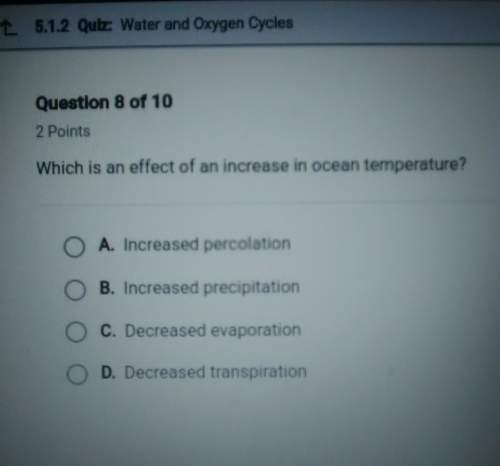
Biology, 02.06.2021 23:10 mckinley2006
Although there is continuity of homeostatic mechanisms reflecting a common ancestry for all life, what is the accepted scientific explanation of why organisms have specific adaptations?
Diversity provides opportunities for symbiotic relationships.
Organisms acquire beneficial adaptations through selective breeding.
Organisms choose to adapt to fill available niches.
Varying environmental factors determine the different traits.

Answers: 2


Other questions on the subject: Biology

Biology, 22.06.2019 02:00, aredding7016
The accompanying figure shows the percent of selected dna sequences that match between a chimpanzee and other primates. these data support the hypothesis that the figure shows the percentage of selected d n a sequences that match between the chimpanzee and other primates. the human has an almost 98 percent match, the gorilla has an almost 97 percent match, the orangutan has a 96 percent match, the gibbon has an almost 95 percent match, and the old world monkey has an almost 92 percent match. the accompanying figure shows the percent of selected dna sequences that match between a chimpanzee and other primates. these data support the hypothesis that the figure shows the percentage of selected d n a sequences that match between the chimpanzee and other primates. the human has an almost 98 percent match, the gorilla has an almost 97 percent match, the orangutan has a 96 percent match, the gibbon has an almost 95 percent match, and the old world monkey has an almost 92 percent match. chimpanzees and gibbons are the most closely related the chimpanzee's closest surviving relative is humans orangutans are the primates least closely related to chimpanzees old world monkeys and gibbons are the most closely related
Answers: 1

Biology, 22.06.2019 04:30, katiedavis7883
Sexual reproduction in the parent cell will result in offspring with a) identical genetic information. b) half the genetic information. c) double the genetic information. d) four times the genetic information.
Answers: 1

Biology, 22.06.2019 07:00, victorialeverp714lg
According the inverse square law, doubling the distance from the source of the sound, a speaker, for example, will drop the sound 6 db each time. if you were standing in the back of an auditorium, 32 feet away from a speaker not using any amplification, would you be able to hear a speaker clearly? why or why not?
Answers: 2

Biology, 22.06.2019 10:30, nonjabulomabaso7423
Subduction zones form when an oceanic plate collides with another oceanic plate or continental plate. the continental crust is lighter and less dense than oceanic crust. continental crust's density is approximately 2.7 grams per cubic centimeter. oceanic crust is thinner and the average density is about 3.3 cubic centimeters. when the two crustal plates converge the oceanic plate always bends and subducts beneath a continental plate. once the oceanic crust subjects, the rocks are subjected to changes in heat and pressure. because of this, we would expect to find rocks in the area of a subduction. a) clastic b) igneous c) metamorphic d) sedimentary
Answers: 2
You know the right answer?
Although there is continuity of homeostatic mechanisms reflecting a common ancestry for all life, wh...
Questions in other subjects:


Physics, 04.07.2019 11:30

Mathematics, 04.07.2019 11:30

Mathematics, 04.07.2019 11:30


Mathematics, 04.07.2019 11:30


Chemistry, 04.07.2019 11:30


Mathematics, 04.07.2019 11:30




